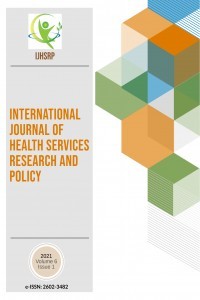THE EFFECT OF PUSHING TECHNIQUES ON DURATION OF THE SECOND LABOR STAGE, MOTHER AND FETUS: A RANDOMIZED CONTROLLED TRIAL
THE EFFECT OF PUSHING TECHNIQUES ON DURATION OF THE SECOND LABOR STAGE, MOTHER AND FETUS: A RANDOMIZED CONTROLLED TRIAL
___
- [1] Cooke, A., ‘‘When will we change practice and stop directing pushing in labour?’’, British Journal of Midwifery, 18 (2), 2010. 76. doi:10.12968/bjom.2010.18.2.46403.
- [2] Genç Koyuncu, R., Demirci, N., ‘‘Effects of pushing techniques during the second stage of labor: A randomized controlled trial’’, Taiwanese Journal of Obstetrics and Gynecology. 56 (5), 606-612, 2017.
- [3]Yildirim, G., Kızılkaya Beji, N., ‘’Effects of pushing techniques in birth on mother and fetus: a randomized study’’, Birth, 35 (1), 25-30, 2008.
- [4] Roberts, JE., ‘‘The push for evidence: management of the second stage’’, Journal of Midwifery and Womens Health, 47, 2–15,2002.
- [5] Lemos, A. et al., ‘‘Pushing/bearing down methods for the second stage of labour’’, The Cochrane Library, 10, 2015. doi:10.1002/14651858.CD009124.pub2.
- [6] Schaffer, JI. et al., ‘‘A randomized trial of the effects of coached vs uncoached maternal pushing during the second stage of labor on postpartum pelvic floor structure and function’’, American Journal of Obstetrics & Gynecology, 192 (5), 1692-1696, 2015. doi:10.1016/j.ajog.2004.11.043.
- [7] Yıldırım, G., ‘‘Doğum eyleminde uygulanan ıkınma teknikleri ve hemşirelik yaklaşımları’’, C.Ü. Hemşirelik Yüksekokulu Dergisi, 10 (2),49-56, 2006.
- [8] Berghella, V. et al., ‘‘Evidence-based labor and delivery management’’, American Journal of Obstetrics & Gynecology, 199 (5), 445-454, 2008.
- [9] Hofmeyr, GJ., ‘‘Evidence-based intrapartum care’’, Best Practice & Research Clinical Obstetrics and Gynaecology, 19 (1),103–115, 2005.
- [10] Tayrac, DR., Letouzey, V.,‘‘Methods of pushing during vaginal delivery and pelvic floor and perineal outcomes: a review’’, Current Opinion in Obstetrics and Gynecology, 28 (6),470-476, 2016.
- [11] Vaziri, F. et al., ‘‘Spontaneous pushing in lateral position versus valsalva maneuver during second stage of labor on maternal and fetal outcomes: A randomized clinical trial’’, Iranian Red Crescent Medical Journal, 18 (10), e29279,1-9, 2016. doi: 10.5812/ircmj.29279.
- [12] Prins, M. et al., ‘‘Effect of spontaneous pushing versus Valsalva pushing in the second stage of labour on mother and fetus: a systematic review of randomised trials’’, BJOG: An International Journal of Obstetrics & Gynaecology, 118 (6) , 662-670, 2011. doi:10.1111/j.1471-0528.2011.02910.x.
- [13] Minato, JF., ‘‘Is it time to push? Examining rest in secondstage labor’’, AWHONN Lifelines, 4 (6), 20-23, 2000.
- [14] Hanson, L., ‘‘Second-stage labor care. Challenges in spontaneous bearing down’’, Journal of Perinatal & Neonatal Nursing, 23 (1), 31-39, 2009.
- [15] Koyuncu, RG., Demirci, N., ‘‘Doğumun ikinci evresinde kullanılan ıkınma tipleri: literatür gözden geçirme çalışması’’, G.O.P. Taksim E.A.H. JAREN, 2 (1),33-39, 2016.
- [16] Bloom, SL. et al., ‘‘A randomized trial of coached versus uncoached maternal pushing during the second stage of labor’’, American Journal of Obstetrics & Gynecology, 194 (1), 10-13, 2006. doi:10.1016/j.ajog.2005.06.022.
- [17] Jahdi, F. et al., ‘‘A randomized controlled trial comparing the physiological and directed pushing on the duration of the second stage of labor, the mode of delivery and Apgar score’’, International Journal of Nursing and Midwifery, 3 (5), 55-59, 2011.
- [18] Mohamed, AI. et al., ‘‘Spontaneous versus valsalva pushing techniques at the second stage of labor among primipara women on labor outcomes’’, Journal of Nursing and Health Science, 4 (4), 82-88, 2015. doi:10.9790/1959-04478288.
- [19] Barasinski, C. et al., ‘‘Do maternal pushing techniques during labour affect obstetric or neonatal outcomes’’?, Gynécologie Obstétrique & Fertilité, 44 (10), 2016. doi:10.1016/j.gyobfe.2016.07.004.
- [20] Hollins Martin, CJ., ‘‘Effects of valsalva manoeuvre on maternal and fetal wellbeing’’, British Journal of Midwifery, 17(5), 279-285,2009.
- Yayın Aralığı: Yılda 3 Sayı
- Başlangıç: 2016
- Yayıncı: Rojan GÜMÜŞ
INTERESTS AND OPİNİONS OF THE SOCİETY ON HEALTH NEWS AND PROGRAMS: A SAMPLE STUDY İN TRABZON
Sedat BOSTAN, Beyler YETKİNER, Tuğba ÇOLAK
FOSTER PARENT’S MOTIVATIONS REGARDING FOSTER CARE: A CROSS-SECTIONAL STUDY FROM SOUTH INDIA
Kurian JOSE, Benil HAFEEQ, Sheeba MUMTAZ, P.j. ANJALİ, N.a. UVAİS
CHANGABLE ENVIRONMENTAL RISK FACTORS IN AUTISM: VITAMIN D AND FOLIC ACID
CANCER RISK FACTORS AND PREVENTION IN TURKEY
Emine KAPLAN SERİN, Ahmet OZDEMIR, Mumin SAVAS
Evaluation of Diastolic Dysfunction in Rheumatoid Arthritis Patients
Özge Turgay Yıldırım, Emel Gönüllü, Fatih Aydın, Ercan Akşit, Ayşe Hüseyinoğlu Aydın, Evrin Dağtekin
Fatma Başar, Seher Şeyma Hürata
Ebru GOKALP-OZKORKMAZ, Nursel GUL, Yusuf OZAY, Sevda GUZEL, Ahmet KAHRAMAN, Hakan ESKIZENGIN
